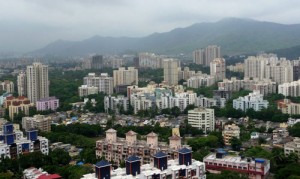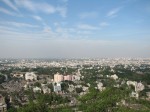 Track2Realty Exclusive: While the infrastructure of Pune has been comparably better than many urban centres across the country, there is no denying the fact that the kind of urbanisation and migration that is happening in the city the load on the infrastructure is increasingly getting heavy. Moreover, since most of the infrastructure has been created by the private developers in the city of late; hence there has been uneven growth of infrastructure across the city.
Track2Realty Exclusive: While the infrastructure of Pune has been comparably better than many urban centres across the country, there is no denying the fact that the kind of urbanisation and migration that is happening in the city the load on the infrastructure is increasingly getting heavy. Moreover, since most of the infrastructure has been created by the private developers in the city of late; hence there has been uneven growth of infrastructure across the city.
The same goes true for both the physical as well as social infrastructure. Though the track record of government agencies in the city has been better than Mumbai and many other metro cities, yet it is generally believed that the city needs more in terms of planning, policies and projects.
As a way forward, analysts are hence demanding pro-active governance for better infrastructure in Pune. This has been a demand which has widely been endorsed by the developers as well. Failing this, they believe, Pune may head towards urban chaos like Mumbai. Urban planners believe since Pune is generating more employment opportunities than Mumbai nowadays, it is time both the Maharashtra Government as well as Pune Municipal Corporation (PMC) gives due importance and infrastructure support to the city.
While there are various proposals for road widening etc, these have to be translated into real time, to be effective. Infrastructure is pivotal in making real estate development feasible and newer areas inhabitable in any city.
Arvind Jain, Managing Director, Pride Group categorically says that an unplanned locality will cater to the requirements of home buyers from significantly divergent socio-economic backgrounds. This not only creates unevenly aligned neighbourhoods but also grave security issues. This is because the people who provide ancillary services in the area tend to come from even lower social strata than the owners of the cheapest homes in the locality. Crime rates tend to be particularly high in emerging locations where property prices are low.
“Non-assorted developers of different projects within a locality do not invest in the area’s infrastructure – their work begins and ends with the project itself. Home buyers are informed that whatever support infrastructure is currently lacking in the area will soon be provided by the municipal corporation. However, the timelines for such local government initiatives are usually hazy at best. This is why the new development mantra of integrated townships has now become the model of the future. The existing and upcoming mega-townships in Pune’s emerging areas such as Dhanori, Charoli and Wakad have taken the task of organized urban planning to the next level,” says Jain.
The question is how far the government has been supportive in supplementing the infrastructure created by the developers? Kishor Pate, CMD, Amit Enterprises Housing admits the process has been slower than ideal, but the government is responsive to the requirements of emerging areas in Pune.
“Proper city planning is the key to holistic development. New areas should be mapped for physical infrastructure first and residential and commercial development afterwards,” says Pate.
Anil Pharade, Chairman, Pharande Spaces agrees that infrastructure has been compromised in the city. According to him, the demand for houses is so high that the buyers are yet opting to buy with compromised infra needs.
“The Pimpri Chinchwad Municipal Corporation, which planned its residential areas decades ago, offers superior residential options. The integrated residential projects in areas like Moshi and Ravet offer the kind of homes that Puneites have always dreamed of, but never been able to own. Because of the regulated nature of the PCMC real estate market and the high emphasis on civic facilities and amenities, there is no question of an eventual infrastructure deadlock,” says Pharande.
Manju Yagnik, Vice Chairperson of Nahar Group maintains that Pune is growing fast and a collective involvement in planned infrastructure development is a must. The city’s infrastructure will undergo an overhaul if the metro work starts in 2014. The availability of huge parcels of land in the periphery of the city, allows it to grow horizontally.
“The city is opening up new areas for real estate development with the support of the city’s road system. There are a few points that can be focused upon to make the infrastructure better. First, proper access roads to support the social infrastructural development and secondly, the speed with which they are implemented will more or less dictate the speed with which newer areas can be developed. These points not only impact the overall demand for residential projects and improve social infrastructure but also will help in the holistic growth of Pune,” says Yagnik.
Advocating for equal focus on developing social infrastructure, Rohit Gera, MD, Gera Developments believes that ssocial infrastructure is created by private institutions as well as the government. The private institutions and businesses are good at filling the gap as it arises when it comes to social infrastructure, whether this is done by the developers who provide club houses in their larger developments or restaurateurs etc. In his opinion, what is lacking is the social infrastructure around the arts – whether it is art, dramatics or the literary arena. The city has seen virtually no new museums, auditoriums etc in decades.
“The role of the government is to provide a certain amount of social infrastructure. At the basic level, public parks and recreational spaces is the responsibility of the city. Unfortunately, the city being a developing city does not have the requisite surplus funds to put in money into the social infrastructure development. There are hundreds of properties handed over to the PMC by developers that are undeveloped and can be converted to assets of the city with some capital. Unfortunately, since the city requires its scarce capital for other infrastructure projects, the gap can only be filled by the private sector,” says Gera.
There is a general consensus within the built environment of Pune real estate market that pro-active governance is needed to address the infrastructure needs of the city. It is believed that Public Private Participation (PPP) for development of physical and social infrastructure like cultural and recreational infrastructure that benefits the larger community beyond the islands of excellence that developers provide in their projects is an absolute necessity.
Experts suggest that there are a number of models one can use to create public private partnerships to develop parks, cultural centers and the like. There have been a few projects undertaken by the private sector that have provided for social infrastructure. The development control rules do allow for this type of development. Pune used to be known as a cultural capital. It is still possible to recapture this title. However, it will take some foresight and initiative from the civic authorities and the elected representatives. More importantly, it is time to look at the load on the physical infrastructure as well.





